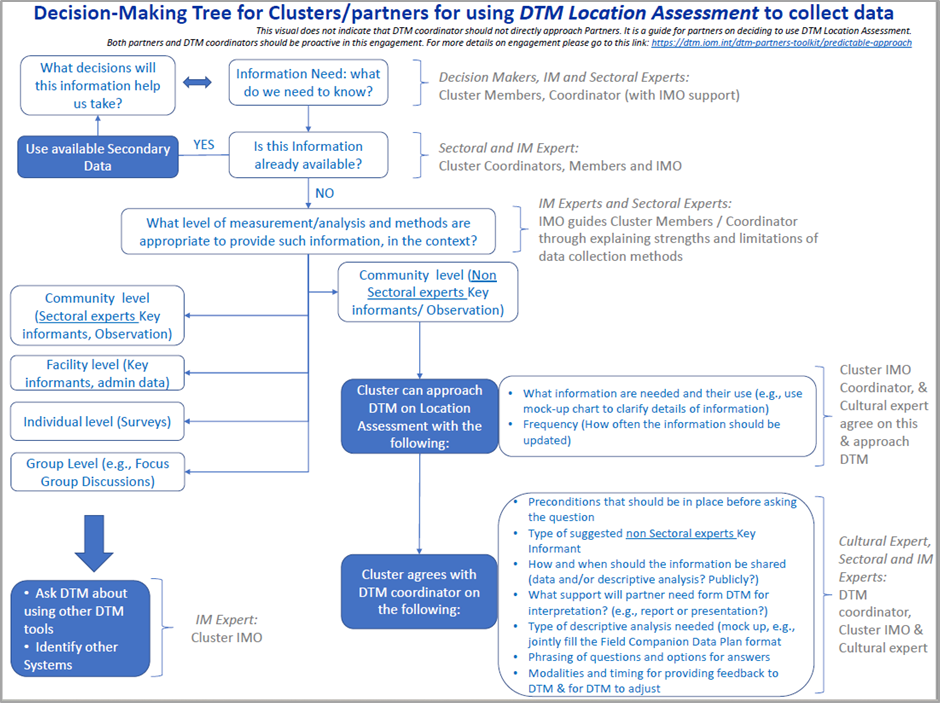Partners (decision makers, subject-matter experts) should start by identifying the decisions they need to make for their response planning and the information they need to make informed decisions (Partners’ Analytical Frameworks can help them identify information needs).
Partners IM/data experts and subject matter experts will review available data and information and identify what they do not have (information needs).
Once they know their information needs, Partners IM and data experts can identify the appropriate sources for each information need. When choosing a source or a method of data collection, they will consider the type of information needed, the likelihood of obtaining an accurate answer, time, cost and ability to access population.
Some of the needed information will be obtained from existing (secondary) data. The partner may also need a new (primary) data collection. In addition, Partners can use DTM MSLA to collect some of the data they need, saving most of the effort and cost of primary data collection, while at the same time ensuring the DTM tools collect exactly the necessary information.
This flow chart "Decision-Making tree for Clusters WG and Partners" helps Partners understand what to consider before approaching DTM

How can Clusters/Sectors/WGs in countries use DTM information?
DTM data are often used to understand scope and scale of displacement, as well as trends. However, they are also used operationally, for example to raise alerts and red flags on locations in urgent sectoral need, and to help prioritize locations for follow up sectoral assessment and other action.
Methods and context have an impact on the information collected in any such exercise. DTM MSLA is not a Sectoral Needs Assessment tool. In its mobility tracking component, DTM does not interview individuals or HH, and DTM enumerators and key informants are not sectoral experts.
DTM, however, has a large and consistent coverage of crisis, can be adjusted to collect information that clusters need, and provides regular updates on critical issues. In addition, its data are collected over time, and can indicate how displacement and conditions of displaced populations evolve over time.
DTM questions are designed to be answered by non-sectoral experts, in a way that results can be used by sectoral experts for analysis.
Ideally, DTM teams provide the clusters with information and possibly descriptive analysis (with Cluster IM experts). Information is then jointly analysed by the cluster members (subject matter experts/decision makers) and context/cultural experts, bringing together available information from all sources.
Available Tools
- Decision making tree for Clusters WG and Partners on using DTM, in: https://dtm.iom.int/dtm-partners-toolkit/predictable-approach
- Methods and Information, in: https://dtm.iom.int/dtm-partners-toolkit/other-tools-0
- Data-collection techniques and appropriate use for each technique (in: UNHCR Assessment Handbook, Table 10, page 81), in: http://needsassessment.unhcr.org/
- FAQ on DTM for Clusters, in: https://dtm.iom.int/dtm-partners-toolkit/what-dtm
- Presentations on What is DTM and what it can do with it, in: https://displacement.iom.int/dtm-partners-toolkit/presentations-dtmen-fr-and-sp
- How to use DTM for:
